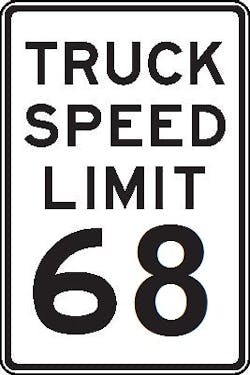Speed limiter comments (Part 1): Fleets support concept, critical of rule's execution
The Dept. of Transportation asked for public input to determine the setting in the proposed heavy-duty truck speed limiter mandate—and it got it. Much of it from the trucking industry , however, is especially critical of that approach, arguing that regulations should be based on data, not opinion polls. So it should be up to the agencies in charge—the Federal Motor Carrier Safety Administration and the National Highway Traffic Safety Administration—to pick a setting and show that it will work.
While typically in favor of the 65 mph option, the fleet comments also urge the agencies to make the rule applicable to as many trucks as possible—not just to trucks built after the rule takes effect.
The American Trucking Assns., which had petitioned the government to come up with a mandate, as a matter of policy supports a national speed limit of 65 mph for all vehicles and tamperproof speed limiters for all heavy-duty trucks made after 1992. But the proposed rule comes nowhere close to meeting those targets, the trade group explains.
ATA’s comment points to a number of shortcomings:
- The rule calls for speed limiters to be required only on new vehicles, and would not require tamperproofing;
- The lack of a national speed limit would result in “wide divergences” in speed between trucks and other traffic; and
- The agencies propose three speed options, with “insufficient evidence” to justify a particular choice.
“Given these deficiencies, ATA cannot support the proposed rulemaking, absent additional data and research demonstrating that it would not create new safety hazards that might outweigh any safety benefits anticipated by the agencies,” ATA writes.
ATA also mentions the proposal's lack of consideration for emerging technologies “that may soon render speed limiters obsolete, by addressing the same concerns without creating the potential risks of the proposed rule,” and notes the agencies admit that they currently have insufficient information from which to draw reasonable conclusions.
ATA also faults DOT for failing to conduct any new research—despite having 10 years to do so—and instead relying on existing and aging studies that doesn’t address many of the key issues. And, for the kicker, without a more substantial proposal, the agencies are statutorily prohibited from moving forward, ATA concludes.
The Truckload Carrier Assn.’s speed limiter policy mirrors that of ATA, and TCA’s comment first addresses the proposal’s “ambiguous” speed limit options.
TCA recognizes that the speed question has “multiple answers and opinions,” as TCA’s motor carrier members have programs set at speeds that reflect their operational needs as well as the geography where trucks travel, the group notes.
“Ultimately, the success and/or failure of this rule will inevitably be determined by which speed the agencies ultimately deem an acceptable level of speed limitation,” TCA writes. “Our members’ decision to develop a policy that calls for limiting speeds at 65 mph is representative of an overall speed in which our members have deemed this as an acceptable level in which to regulate.”
TCA likewise questions the lack of a retrofit, the creation of speed differentials between trucks and other traffic, and emerging technologies.
Among carriers submitting comments:
- J.B. Hunt Transport Inc. suggests that if trucks are speed-limited, enforcement should shift away from commercial vehicles on interstate highways to state and local roads and to passenger car behavior around trucks, leading to a “significant” increase in lives saved, beyond the proposed rule’s projections.
- C.R. England Inc. writes that it supports the speed limiter rule, and urges the adoption of the 65 mph speed setting, as well as making the rule applicable to all heavy-duty trucks.
- Roehl Transport Inc. also supports the proposal. Noting that its trucks are currently governed at 63 mph, Roehl favors either the 65 mph or 68 mph option. “Since governing our trucks, we find that the difference in a higher speed limit and our governed speed is not a contributing factor to accidents we have been involved in,” Roehl says.
- YRC Worldwide Inc. notes the companies now under its corporate umbrella each “voluntarily adopted SLD’s decades ago in recognition of their safety, performance, and environmental benefits.” But YRC is concerned about the research behind the proposal, and would like the agencies to find a correlation between speed limiters (not just lower speeds) and safety. YRC, whose drivers are Teamsters, also notes that lower speeds and reduced productivity “represents a significant pay reduction for drivers and their families”—especially “in light of the severe driver shortages impacting the industry.”
- FedEx Corp. supports the rulemaking and favors a setting of 65 mph. In its comments, FedEx notes the speed differential argument “is refuted by the research.” FedEx also suggests that GPS-based speed limiter systems could make the roads safer by addressing the actual speed limit on a stretch of highway. In its comments, FedEx voices support for several other technologies that could improve safety, including lane departure warning and collision avoidance and mitigation systems.
- Covenant Transportation Group Inc. writes that its company trucks all have governed for “decades,” and that “CTG believes strongly that governing speed is the safest way to operate a fleet of trucks, results in less frequent accidents, and most importantly reduced severity.” However, CTG says it’s “unfortunate” the proposal does not deal with speed differentials and that the proposal doesn’t offer more science to support a specific speed recommendation contained within the NPRM. CTG recommends a maximum speed of 65 mph.
Up next: Comments from owner-operators and small business truckers.
About the Author
Kevin Jones 1
Editor
Kevin has served as editor-in-chief of Trailer/Body Builders magazine since 2017—just the third editor in the magazine’s 60 years. He is also editorial director for Endeavor Business Media’s Commercial Vehicle group, which includes FleetOwner, Bulk Transporter, Refrigerated Transporter, American Trucker, and Fleet Maintenance magazines and websites.

